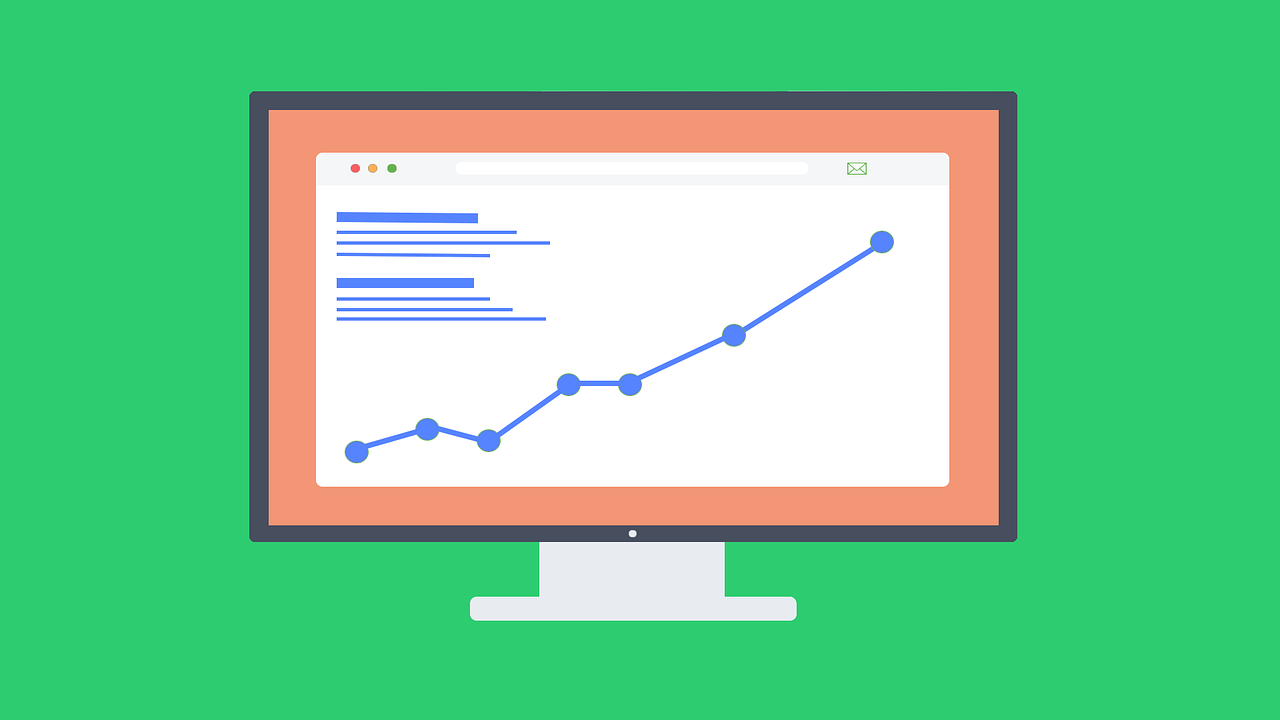
This is a guest post from Irina Linnik, a marketing specialist at Onilab. Her work has been published on Smart Insights and Paymill.
Successful eCommerce marketers know how crucial SEO is for their listings.
Competition is incredibly tight, so sellers vie for organic traffic and visibility in search engine results. As such, SEO optimization is the decisive factor in store ranking and user engagement.
Marketers pay close attention to the optimization of product pages, images, content, and other site elements. However, many of them overlook the product listing pages, or PLPs, which are the real power brokers that earn your listings visibility.
Learn why SEO optimization for PLPs matters so much and how these pages bring traffic and revenue to your store.
Product listing pages: What they are and why they matter
PLPs are the pages that display products, typically within a specific category or filter.
These product listings are usually the result of a search (either in the browser or on a site) for a specific product type. For example, if a user searches for “summer women shoes,” the PLP will display all products that contain these keywords.
Many marketers neglect PLPs when it comes to SEO, assuming that search engine optimization is reserved for blogs and main webpages. However, product pages deserve your SEO attention, as they can also contribute to store traffic and ranking.
Internal linking
SEO specialists understand the importance of internal linking; a page that contains several backlinks has a higher link value. Internal linking also helps search engines better understand the site’s structure, which assists indexing and ranking.
You may be surprised to find PLPs have an overwhelming number of backlinks compared to other pages. While an ordinary product page may have a few internal links, a PLP has links from all listed products. This makes product listing pages major assets to your online store’s SEO and link value.
Extensive keyword presence
Keywords are essential, as they bring users to your pages.
If your product page has the keywords “red flat shoes women” in the product description for example, chances are high your store will display on the first pages of the search results. This is due to the string being specific, allowing it the possibility to match the exact keywords on the product page.
However, because product pages focus solely on one product, their product descriptions are limited to specific keywords.
In contrast, product listing pages contain a set of keywords for each product page. This significantly raises PLP value.
Also, search results display PLPs with broader keyword inputs. Try typing “women’s shoes” and you’ll see the PLPs for the biggest online retailers with all their women’s shoe collections. Capitalize on the keyword opportunities your PLPs present and you’ll be on your way to securing powerful organic rankings.
SEO optimization tips for product listing pages
PLPs can boost your store’s SEO, but they require thoughtful optimization like any other page on your site. Invest time in fine-tuning your product listing pages to help them reach peak performance in organic search results.
Take care with the title
The title of your product listing page usually matches the keywords users input into their searches.
For example, if you search “womens boots” on Google, you’ll see the following results:
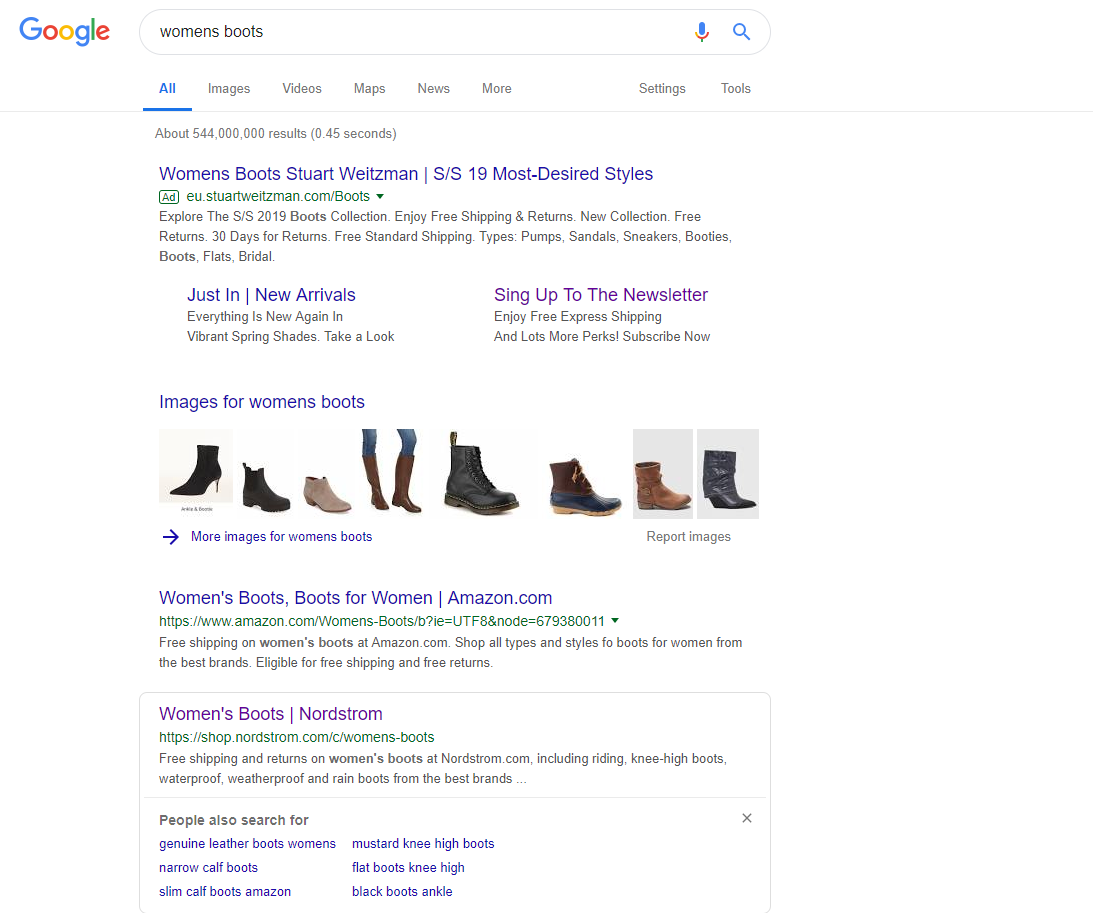
As you can see, the title of the Nordstrom PLP is exactly the same as the keyword phrase we used.
A title tag is an HTML element that describes a specific page’s content. Title tags are displayed on:
- Search engine result pages (SEPRs)
- Top of web browsers
- Social networks (upon sharing the page)
Your title must contain relevant keywords. But try to keep the length under 60 characters, and don’t flood it with keywords. Unlike a product page, a product listing page is less specific and has no need for a complicated, overly descriptive title (e.g., “Women’s Red Leather Boots”).
Create a strong meta description
A meta description is a short snippet of text that describes a web page and its content. This HTML attribute displays in the search results under the page title, and influences a store’s click-through rate (CTR).

Google usually cuts meta descriptions to 155–160 characters each, so try to stick to this word count.
Remember, when creating a meta description, you have to “sell” your page to users to entice them to click on it. Write it in an engaging manner, and be generous with relevant keywords.
Note: Meta descriptions don’t officially influence the site ranking, but affects the CTR (which does impact your ranking). So, devote time to writing a converting and SEO-friendly description.
Optimize your images
A PLP contains dozens of images and product descriptions from product pages. To increase the value of your PLP, you have to optimize the elements present on this page.
Image optimization is an important SEO aspect that many eCommerce marketers neglect. It helps your pictures appear in image search results, which drives users to your store.
Here are the main elements of image optimization.
Title name
Your title name informs search engines of the image’s content. Some companies also display the title upon hovering the mouse over the image.
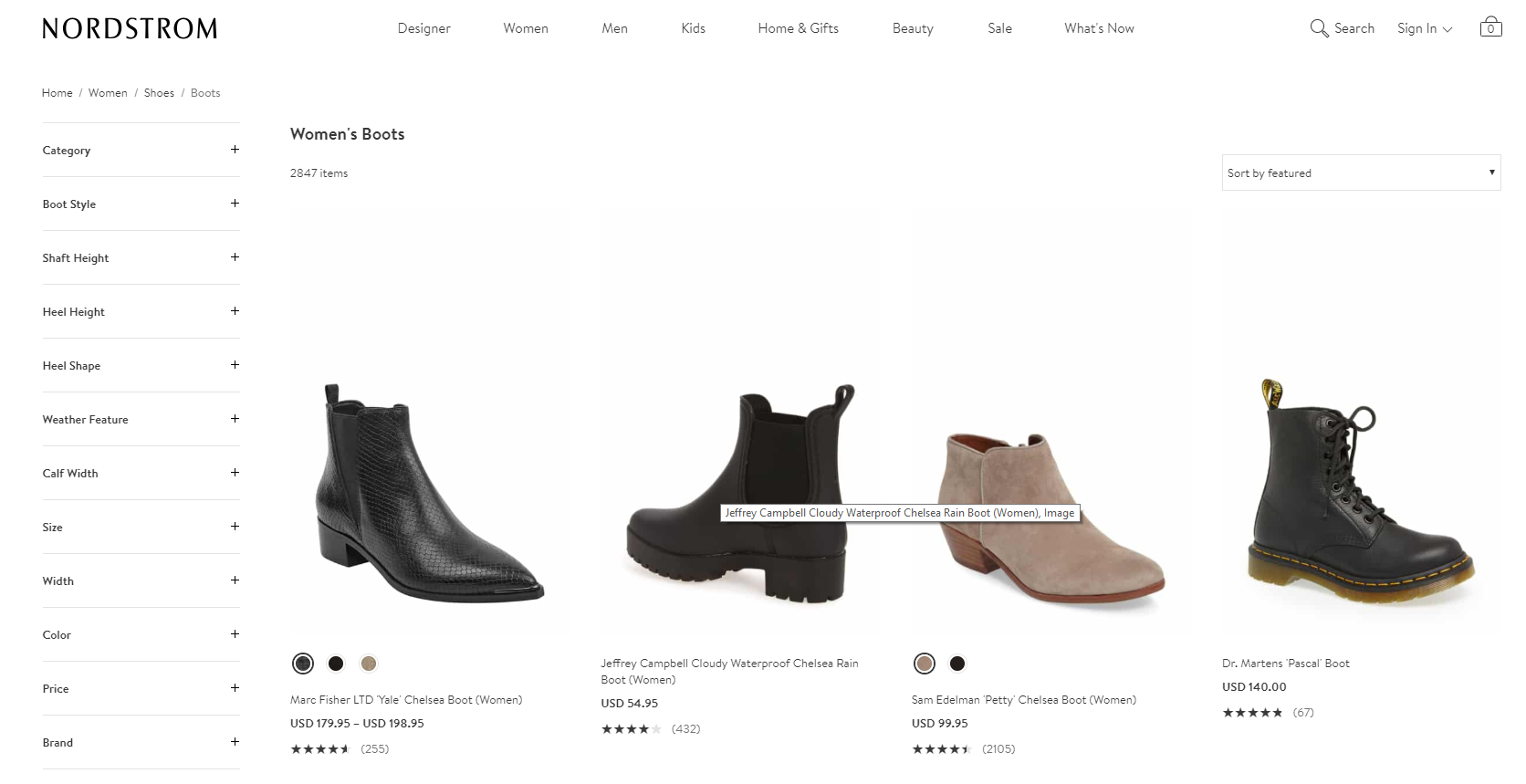
Alt text
Alt text is a text snippet that appears when the image fails to load. It tells users and search engines what the image is about and contains a relevant keyword (or a few).
Alt text is an accessibility feature, but its use of keywords provides major SEO benefits for your PLPs. Be sure to update the alt text for any images shared on your site for maximum visibility.
Image size
Slow loading time harms a page’s ranking. Heavy, unoptimized images are among the top reasons why your page may be slow. To get into Google’s good books, you need to improve your page speed.
Google’s Core Web Vitals tells us everything we need to know about the importance of site speed, and optimizing images is a well-known trick to improve performance.
So, choose an appropriate size and file type for your image, and keep an eye on your image quality.
Optimize product description
Product descriptions convince users to buy your product by educating them on its features and advantages.
In brick-and-mortar stores, users can handle the products; in an online store, however, they can only look at images and read the descriptions. So, your descriptions need to be clear, specific, and graphic to bridge this gap and help shoppers visualize themselves using your product.
The essentials of creating an SEO-friendly product description include:
- Write for users, not bots. Keep a friendly, lively tone to encourage users to learn more.
- Include keywords to increase visibility.
- List product benefits to promote a purchase.
- Combine features and benefits. Describe the product and its value.
Your PLP presents an opportunity to share a broad category description that covers all products listed. Take advantage of the potential power of optimizing product listing page descriptions.
Optimize URLs
A URL indicates a page’s relevance to a search query, so it’s important the URL contains relevant keywords.
In the Nordstrom example above, the URL of the product listing page is “https://shop.nordstrom.com/c/womens-boots”
This clearly displays the kind of products people can discover on the page.
Other tips for URL optimization are:
- Use hyphens, because Google can’t read underscores.
- Only include lowercase letters.
- Ensure the URL is readable and clear.
By inserting relevant keywords into your product listing page’s URL, Google can easily discern what type of products users should expect to see on your PLP. As such, Google will understand when to show your PLPs on search result pages.
So, write logical category URLs to have your PLP show up in relevant search results.
Highlight positive reviews
If people are saying good things about your products, show off those kind words!
Adding reviews to your product listing pages boosts credibility and can increase buy-in from shoppers who are sitting on the fence. Reviews can also boost your SEO.
Customers who use reviews to share their product experience can unknowingly generate long-tail keyword rankings for your products. In turn, your product listing pages might creep up in SERPs for relevant search terms as Google deems your PLP content useful and relevant.
From an SEO perspective, product reviews also act as trust signals for your brand. Moz conducted an in-depth review of local search ranking factors and found reviews had one of the top roles in increasing organic search performance.
Outside of SEO, online shoppers love to see reviews. In fact, 77% of consumers “always” or “regularly” read reviews, according to research by BrightLocal.
Your product listing pages can only accommodate so much content. When customers add reviews to your product listing pages though, they form new, unique content that Google can crawl and index. You can display reviews as star ratings on PLPs, as well as on the individual product pages. The quantity, diversity, and velocity of reviews all can contribute to your organic rankings.
Tips for gaining more reviews
To gather honest product feedback from your customers, you need to ask for it.
Here are some ways you can encourage customers to write reviews:
- Work review requests into your post-purchase email flow
- Incentivize customers to share their feedback
- Make it easy for people to leave reviews
- Share reviews on social media
Focus on building strong relationships with your customers, and check in with them post-purchase with a genuine inquiry about their product experience. Remember, it’s always a “no” if you don’t ask.
Mark up product listing pages with structured data
Schema markup is a type of structured data that tells Google more about your site.
It requires knowledge of front-end coding, so tech-savvy individuals would best utilize it. With that said, there are generators, testing tools, and guides you can use to create structured data for your site.
eCommerce schema markup can display an array of information about your products in Google SERPs. Reviews, product ratings, local store information, and price ranges are all examples of valuable information you can add to your product listing pages. Product schema markup will help your products shine in search results.

In the above example, Best Buy’s Google search result for “iPad Air” features structured data for the product rating, number of reviews, price rate, delivery information, and stock availability. Consumers can gain a wealth of information from a single line in SERPs.
The power of structured data lies in semantics.
Structured data provides Google with a wealth of information about your products. As a result, Google crawlers better understand them, so your chances of those product categories, or PLPs, appearing higher in relevant search result pages increases too.
Cross-sell other products on your PLPs
Speaking of semantics, cross-selling other products on your PLPs strengthens both connections between related products and, of course, your SEO performance.
Use your product listing page to tell customers about other products they may enjoy. These cross-sell features help online shoppers discover more products and encourage them to add more items to their online cart.
Leverage cross-selling to:
- Display best-selling products in a given collection
- Share a “shop this look” collection of related product suggestions
- Make personalized recommendations based on user behavior
- Showcase related categories to link to other PLPs
Implementing cross-selling into your PLPs improves your organic rankings by reinforcing your internal linking profile. Pointing to “category B” from “category A” lets Google crawlers know those two collections are related. This internal connection helps Google establish an information hierarchy between your products and shares link equity throughout your site.
Use cross-selling to boost your internal links and help your products rank higher in search results.
3 Examples of optimized product listing pages
Soak up some inspiration for your PLPs with the following examples of optimized pages. These brands prove you can create product listing pages that perform well organically without skimping on functionality or creativity.
1) Nike
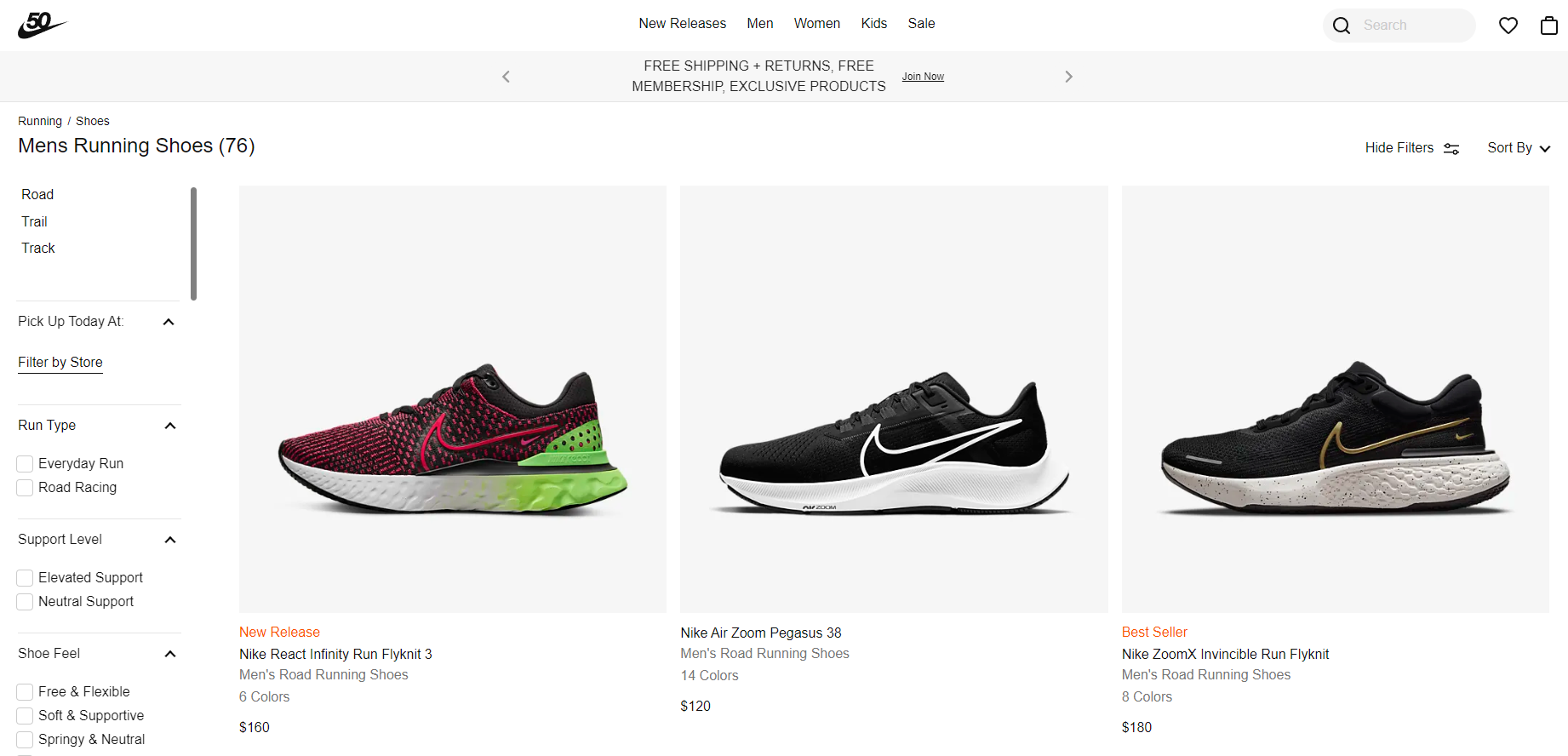
I couldn’t share examples of winning product listing pages without talking about the sportswear giant, Nike.
On their product listing page, Nike shares as much information as possible while keeping the pages fresh and easy to navigate.
Nike’s product listing page URLs are clearly defined and well structured, ticking the box for relevant keywords. The main body of the PLP shows products relevant to that particular category, which naturally act as internal links.
As you move toward the bottom of the product listing page, Nike shows a linked list of related categories for similar PLPs. Underneath this sits a row of related news stories centered on topics relevant to the PLP. All of these are smart PLP elements that boost their internal linking structure and help Google better understand their page content and how to rank them in search results.
The proof of their optimization is in their organic performance: Nike’s Men’s Running Shoes PLP ranks for 11,500 keywords and drives 126,600 organic clicks to their site every month.
2) Tarte Cosmetics
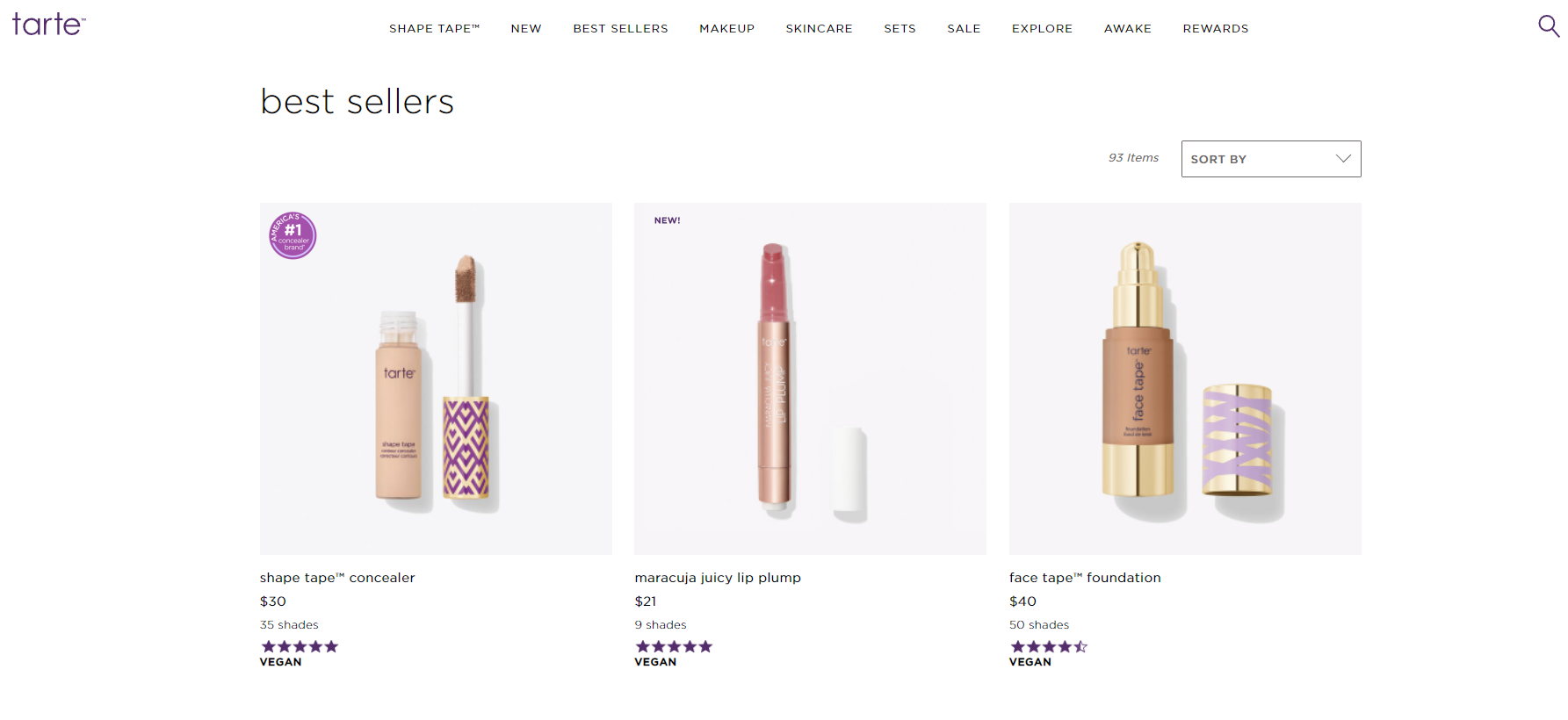
Tarte Cosmetics is a cosmetics company offering eco-friendly makeup and skincare products. Their best sellers PLP ranks for over 800 keywords, demonstrating its organic authority.
On their category page, Tarte Cosmetics features product ratings so potential buyers and Google can both see their best-rated products. The makeup brand has gone the extra mile to ensure these reviews are marked up using structured data, which helps boost their organic rankings.
Tarte Cosmetics also breaks up product tiles on their PLP with related product tiles — a great way to cross-sell products and share link equity between pages.
Finally, a category description can be found at the bottom of Tarte Cosmetics’ PLP, containing broad, relevant keywords to capture more visibility in organic search results.
3) Shane Co.

Shane Co. is an enterprise privately owned jeweler in the United States. A company that large faces high expectations for their SEO, and the performance of their PLPs doesn’t disappoint.
Shane Co.’s product listing pages are beautifully designed. They steer clear of the traditional grid format by breaking their PLPs up with descriptive content blocks, social media photos, rows of relevant product collections, and roll-over animations. While these features may not typically appear on PLPs, they all help boost the organic performance of Shane Co.’s product listing pages.
Their wedding bands category page has secured over 3,800 keywords, demonstrating the organic power this PLP wields. The URLs for their product listing pages are well organized and follow a logical structure, making it easy for Google to understand each page’s content. Meanwhile, content blocks allow Shane Co. to secure even more keywords by sharing detailed information relevant to its PLP.
Shane Co. also takes care to include helpful links to relevant internal pages, further boosting their organic rankings by creating an association between useful on-site content. Their wedding bands PLP, for example, ends with a wedding rings FAQ, which is a smart way to capture keywords and satisfy consumers’ search queries.
Wrapping up — Leverage product listing page optimization to win eCommerce SEO
Product listing pages are important for your store, as they inform visitors about your items, help search engines find you, and contribute to the store’s overall ranking.
Your store’s performance is an important aspect of SEO optimization. Google considers site load speed to be a ranking factor because high performance shapes a positive user experience, and vice versa.
Published: April 5, 2019 as a guest post
Updated: June 9, 2022 via internal expansion